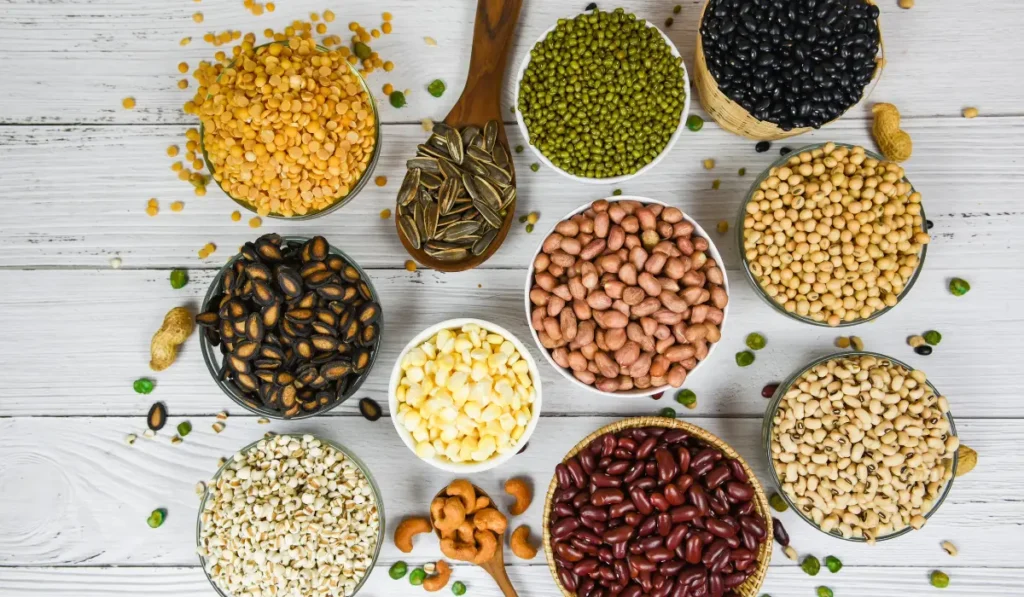Eating a variety of foods from the five main food groups is not just beneficial; it’s essential for maintaining a healthy diet. The Healthy Diet Plate, devised by nutrition experts at the Harvard T.H. Chan School of Public Health, serves as a visual guide to selecting nutritious foods to eat, incorporating fruits, vegetables, proteins, whole grains, and dairy into our daily meals. So many health conditions, ranging from weight management to chronic diseases like diabetes and cardiovascular health, can be positively impacted by a good diet .
Incorporating more fruits and vegetables, along with other key components such as beans and whole grains, into a Mediterranean diet framework, aids in achieving a balance of nutrient-dense foods. This approach helps ensure we’re getting a wide range of antioxidants and healthy fats, which are crucial for a well-rounded, nutritious meal plan. As we delve into the specifics of what makes a diet ‘healthy,’ including the roles of proteins, whole grains, and hydration, we aim to create a sustainable healthy diet meal plan that promotes overall well-being.
Know the basics of a balanced diet. What is a balanced diet?
A balanced diet is foundational for good health and involves consuming a variety of foods in the right proportions to achieve and maintain optimal health and prevent diseases. The Healthy Diet Plate model suggests filling half of your plate with vegetables and fruits, one-quarter with whole grains, and the remaining quarter with protein sources, emphasizing the importance of diet quality over quantity 1. This model helps ensure that we consume nutrient-dense foods, which are crucial for our body’s functioning.
The World Health Organization outlines that a healthy diet includes not only the right balance of foods but also controlled consumption of salt, sugar, and fats to prevent noncommunicable diseases such as diabetes and heart conditions. Specifically, it’s recommended to limit salt intake to less than 5 grams per day and free sugars to less than 10% of total energy intake, while ensuring that total fat does not exceed 30% of total energy intake.
Moreover, the Dietary Guidelines for Americans highlight the importance of focusing on fresh and whole foods; suggesting that the majority of our calories should come from fruits, vegetables, whole grains, legumes, nuts, and lean proteins. It also advises limiting the intake of empty calories often found in processed foods, which contribute little nutritional value to our diets. This approach not only helps in maintaining a healthy weight but also supports overall physiological health, enhancing both physical and mental performance.

Incorporating More Fruits and Vegetables
To effectively incorporate more fruits and vegetables into our diets, it’s essential to understand their nutritional benefits and practical ways to include them in our meals. Fruits and vegetables are not only rich in essential vitamins, minerals, and antioxidants but also provide dietary fiber, which can improve digestion and prevent chronic diseases .
1. Variety and Servings
Start by diversifying the types of fruits and vegetables you consume. Aim to fill half of your plate with colorful vegetables, excluding starchy ones like potatoes. For fruits, consider the whole fruits such as apples or oranges as one serving and for dried fruits, a quarter cup suffices. Incorporating different colors and types ensures you get a wide range of nutrients and makes your meals more visually appealing.
2. Practical Tips for Daily Diet
- Hydration through Fruits: Include hydrating fruits like watermelon in your diet, which retains 92% of the liquid consumed, aiding in meeting your daily fluid needs.
- Snacking and Meals: Utilize fruits and vegetables for snacks; for instance, carrots or celery with dip, or fresh fruits like grapes or bananas. Add extra vegetables to your main dishes, such as mixing diced zucchini in spaghetti sauce or including leafy greens in your rice dishes.
- Utilizing All Forms: Don’t shy away from frozen or canned fruits and vegetables, as they offer similar nutritional benefits to fresh produce and are great for long-term storage.
3. Exploring New Options
Regularly explore the produce aisle for new types of fruits and vegetables to keep your diet interesting and nutritious. Try new recipes that feature fruits and vegetables as main ingredients, which can be found in resources like USDA’s MyPlate or various healthy cookbooks. This not only enhances your culinary experience but also ensures a richer intake of beneficial plant compounds.
By integrating these strategies into your daily routine, you can significantly enhance the nutritional quality of your diet, promoting better health and well-being.
The Role of Proteins and Whole Grains

Knowledge about proteins
Proteins are fundamental to our body’s health, involved in growth, repair, and immune functions. Regular consumption of nutrient-dense protein sources like lean meats, poultry, fish, and plant-based options such as beans and legumes is crucial. These proteins not only support muscle and tissue structure but also aid in enzymatic and hormonal functions across the body.
Whole Grains as a Nutritional Powerhouse
Whole grains significantly contribute to our dietary needs, offering a more nutrient-rich choice over refined grains. The inclusion of whole grains in our diet enhances overall health, providing essential fibers, phytochemicals, and minerals. These components are vital for maintaining steady blood sugar levels and improving digestive health. Moreover, whole grains have been shown to reduce the risk of chronic diseases such as type 2 diabetes and cardiovascular diseases.
Integrating Whole Grains and Proteins into Your Diet
To effectively integrate whole grains and proteins into your diet, consider the following tips:
- Choose Whole Over Refined: Opt for whole grains like brown rice, quinoa, and whole-wheat products to ensure you get the full spectrum of nutrients including bran and germ benefits.
- Diverse Protein Sources: Include a variety of protein sources in your meals, from animal-based options like turkey and fish to plant-based choices such as legumes and nuts.
- Check Ingredients: When purchasing grain products, look for ones where whole grains are listed as the first or second ingredient to guarantee a higher whole grain content.
By adopting these practices, you can enhance your diet’s nutritional quality, promoting better health outcomes and contributing to long-term wellness.
Balancing Fats, Sugars, and Sodium
Balancing Fats, Sugars, and Sodium
Managing the intake of fats, sugars, and sodium is crucial for maintaining a healthy diet. Here’s a practical approach to balancing these elements:
1. Understanding Limits and Recommendations
- Sugars: Limit added sugars to no more than 10% of total daily calories for individuals aged 2 and older, avoiding them entirely for infants and toddlers.
- Fats: Saturated fats should be limited to less than 10% of total daily calories. Instead, use unsaturated oils like olive and canola oil, which can help lower cholesterol.
- Sodium: Aim to consume less than 2,300 mg of sodium per day, which is the equivalent of about one teaspoon of salt.
2. Practical Tips for Everyday Choices
- Beverages: Opt for water instead of sugary drinks like sodas and fruit juices, which offer calories but little nutritional value.
- Alcohol: It’s advisable to limit alcohol intake to two drinks or less per day for men and one drink or less for women to avoid dehydration and excess calorie intake.
- Cooking and Shopping: When grocery shopping, choose products with lower sodium content and check labels to ensure that whole grains are listed as the main ingredients in grain products.
3. Substituting Healthier Alternatives
- Fats: Incorporate healthy fats into your diet by using oils derived from vegetables such as corn, sunflower, and peanut oil in moderation 1.
- Snacks and Meals: Replace high-sodium and high-sugar snacks with healthier options like fresh fruits and vegetables or nuts 19.
By adhering to these guidelines and making informed choices, you can significantly improve the balance of fats, sugars, and sodium in your diet, contributing to overall health and well-being.
Hydration and Healthy Drink Choices

Optimal Beverage Choices for Hydration
Staying adequately hydrated is a cornerstone of health, and choosing the right beverages can significantly impact your hydration status and overall health. Water remains the superior choice for hydration due to its accessibility and absence of calories. For those seeking a bit of variety, fruit-infused water provides a flavorful alternative without the added sugars found in many commercial drinks. Similarly, herbal teas offer hydration along with a dose of antioxidants, making them almost as beneficial as water.
Nutrient-Enhanced Hydration Options
While water is essential, other beverages can contribute beneficial nutrients along with hydration. Milk and unsweetened milk alternatives offer hydration coupled with nutrients like calcium and protein, essential for bone and muscle health 11. Coconut water is another excellent option, boasting a 95% water content along with important electrolytes necessary for hydration balance, especially after physical activities.
Monitoring and Managing Daily Hydration
It’s vital to monitor your hydration status to ensure you’re drinking enough fluids throughout the day. A practical tip is to observe the color of your urine; aiming for a light, pale yellow which indicates proper hydration. Carrying a reusable water bottle can help maintain hydration by allowing for frequent sips throughout the day, ensuring you meet your daily water intake needs. For those who exercise regularly or engage in prolonged physical activity, including sports drinks can be beneficial as they contain electrolytes that aid in more effective hydration.
Meal Planning and Preparation Tips
Meal planning is not just a chore; it’s a strategy to enhance our lives by saving time, reducing stress, and ensuring a nutritionally balanced diet. By setting aside a specific day each week to plan meals, shop, and prepare food, we can eat well even on a budget.Here’s a guide to making meal planning a seamless part of your routine:
Step-by-Step Meal Preparation
- Choose Your Day: Pick a day that works best for you and your family to sit down, plan the upcoming week’s meals, and shop for the necessary ingredients.
- Start Cooking: Begin with the foods that take the longest to cook, such as proteins and whole grains, and make use of this time to prep other items like vegetables and legumes.
- Prep in Batches: Cook large quantities of staples like grains, beans, and proteins. Store these in the fridge or freezer in clearly labeled containers with dates to ensure they are used in a timely manner.
- Organize Your Fridge: Place highly perishable items like greens and herbs at eye level to remember to use them first. This helps in reducing waste and saving money.
Practical Tips for Efficient Meal Planning
- Inventory Checks: Regularly check what you already have in your fridge and pantry to avoid buying duplicates and to use up items that are nearing their expiration.
- Portion Control: Use portion calculators to ensure you’re preparing the right amount of food, especially useful when hosting or cooking for larger groups.
- Diversify Your Meals: Plan meals that use similar ingredients in different ways throughout the week to keep meals interesting and budget-friendly.
By integrating these strategies into your weekly routine, you can create a meal planning system that not only saves time and money but also contributes to a healthier lifestyle.
Conclusion
Throughout this guide, we’ve traveled through the foundations of a balanced diet, highlighting the importance of incorporating a variety of nutrient-dense foods from all the main food groups. By adopting the practical suggestions provided, from meal planning to making smart dietary choices, individuals can significantly enhance their nutritional intake, supporting overall health and well-being. The emphasis on fruits, vegetables, lean proteins, whole grains, along with balanced intake of fats, sugars, and sodium, outlines a path towards achieving and maintaining a healthy lifestyle.
The journey towards a balanced life through diet necessitates commitment and an openness to adjusting one’s eating habits. As we’ve explored, the benefits of such adjustments extend far beyond weight management, impacting every aspect of physical and mental health. Encouraging further exploration and adaptation of these guidelines within one’s personal dietary preferences can lead to lifelong benefits. Ultimately, the message is clear: mindful eating, informed by the principles outlined here, is a key step towards unlocking a healthier, more vibrant life.
FAQs
1. What does the 7-day challenge for healthy diet entail? The 7-day challenge diet, also known as the GM Diet Plan, is structured as follows:
- Day 1: Consume only fruits.
- Day 2: Eat a variety of vegetables.
- Day 3: Combine fruits and vegetables.
- Day 4: Have bananas and milk.
- Day 5: Include meat in your diet.
- Day 6: Eat meat alongside vegetables.
- Day 7: Finish with rice, fruits, and vegetable juice.
2. How can a beginner start eating healthier? For beginners looking to adopt a healthier diet, here are eight practical tips:
- Base your meals on high-fiber starchy carbohydrates.
- Increase your intake of fruits and vegetables.
- Include more fish in your diet, particularly oily fish.
- Reduce consumption of saturated fats and sugars.
- Limit salt intake to no more than 6 grams per day.
- Maintain an active lifestyle to support a healthy weight.
- Ensure you stay hydrated throughout the day.
- Never skip breakfast, as it kickstarts your metabolism.
3. What constitutes a balanced diet menu? A balanced diet menu should include:
- At least 5 servings of a variety of fruits and vegetables each day.
- Meals based on high-fiber starchy foods like potatoes, bread, rice, or pasta.
- Some portions of dairy or dairy alternatives, such as soya drinks, to ensure a well-rounded intake of nutrients.
4. What is an effective eating schedule for weight loss? An optimal eating schedule for weight loss might look like this:
- Make breakfast the largest meal of your day.
- Have a mid-sized lunch and a small dinner.
- Finish dinner at least four hours before bedtime.
- Aim to eat lunch before 3 p.m. to allow for better digestion and metabolism.